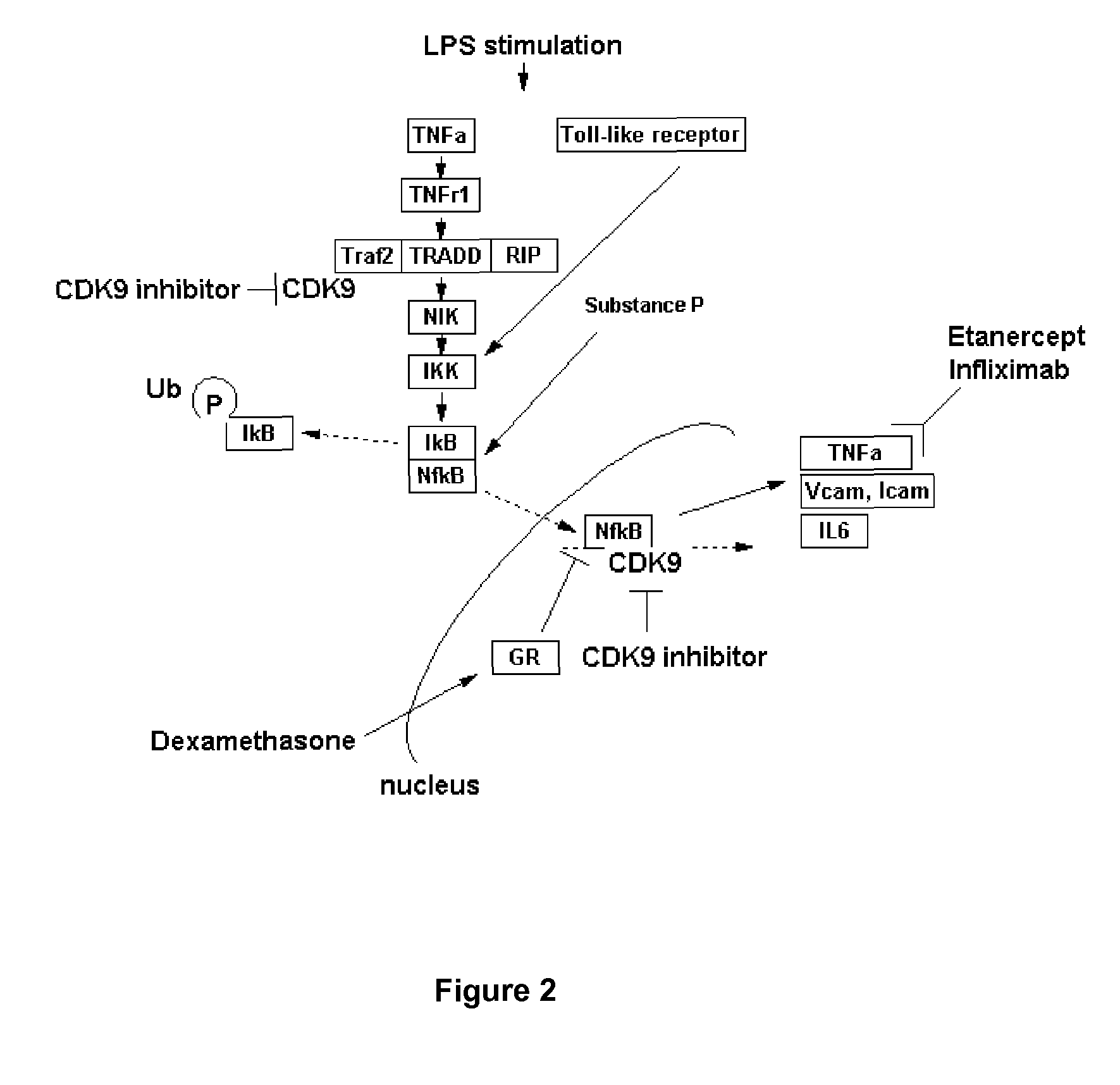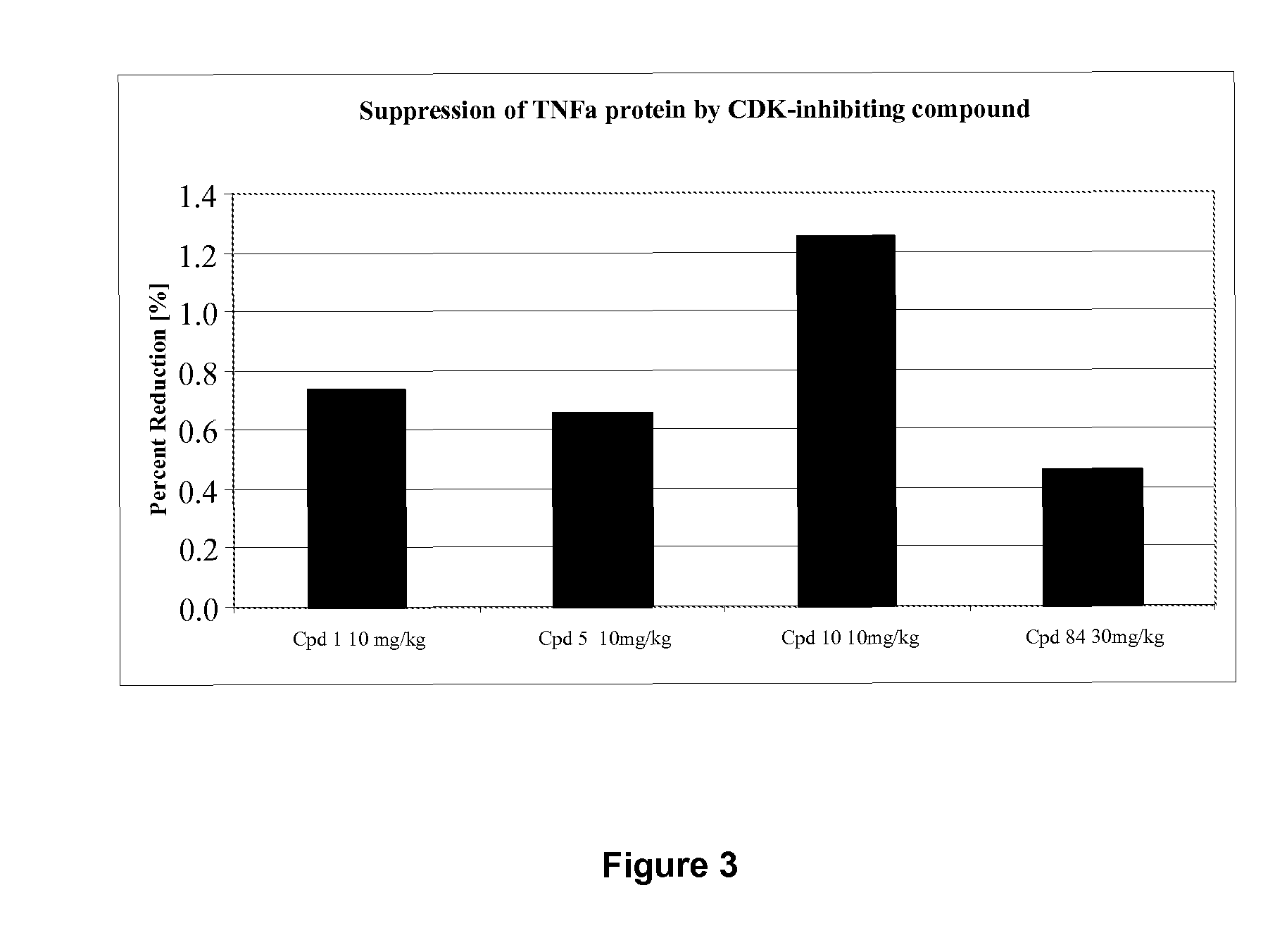4, 6-disubstituted aminopyrimidine derivatives as inhibitors of protein kinases
a technology of aminopyrimidine and aminopyrimidine, which is applied in the direction of biocide, drug composition, immunological disorders, etc., can solve the problems of not being able to inhibit rna polymerase-regulating cdks, affecting the synthesis of rna polymerase, and having partially effective, debilitating or dangerous side effects
- Summary
- Abstract
- Description
- Claims
- Application Information
AI Technical Summary
Benefits of technology
Problems solved by technology
Method used
Image
Examples
example 1
Synthesis of {3-[6-(2-Ethoxy-phenyl)-pyrimidin-4-ylamino]-phenyl}-methanesulfonamide (Compound 1)
[0423]
a. Synthesis of (3-nitrophenyl)methanesulfonyl amide
[0424](3-Nitrophenyl)methanesulfonyl chloride (4.71 g, 20 mmol) was dissolved in acetonitrile (20 mL), then to this solution was added concentrated aqueous ammonia (20 mL) saturated with ammonium carbonate and the reaction mixture was vigorously stirred for 1 h at room temperature. Then acetonitrile was evaporated, the residue was diluted with cold water (20 mL), which led to a precipitate formation. The precipitated was filtered off and washed with water (2×5 mL) and ether and dried under reduced pressure. Yield of (3-nitrophenyl)methanesulfonyl amide 3.5 g (80%)
b. Synthesis of (3-aminophenyl)methanesulfonyl amide
[0425](3-nitrophenyl)methanesulfonyl amide (3.5 g, 16 mmol) was hydrogenated over Raney nickel (0.5 g) in methanol at 50° C. and 70 psi for 4 h, then the catalyst was filtered off, washed with warm methanol, the combined...
example 2
Synthesis of (3-[6-(2,3-dimethoxyphenyl)-4-pyrimidinyl-aminophenyl)-methanesulfonamide (Compound 2)
[0432]
a. Synthesis of (3-nitrophenyl)methanesulfonamide
[0433]The same procedure as for Compound 1.
b. Synthesis of (3-aminophenyl)methanesulfonamide
[0434]The same procedure as for Compound 1.
c. Synthesis of 4-chloro-6-(2,3-dimethoxyphenyl)-pyrimidine
[0435]The same procedure as for Compound 1.
d. Synthesis of (3-[6-(2,3-dimethoxyphenyl)-4-pyrimidinyl]aminophenyl)methanesulfonamide (Compound 2)
[0436]The same procedure as for Compound 1.
[0437]Yield: 0.100 g (55%).
[0438]Melting point 146.9-150.0° C.
[0439]1H-NMR (400 MHz, DMSO-d6); δ (ppm) 3.75 (3H, s), 3.87 (3H, s), 4.28 (2H, s), 676 (2H, br. s), 7.05 (1H, d), 7.19 (2H, d), 7.35 (3H, m), 7.42 (1H, t), 7.66 (1H, s), 7.80 (1H, d), 8.68 (1H, s), 9.67 (1H, br. s).
[0440]Cl MS m / z 401 (MH+)
example 3
Synthesis of (3-[6-(2-methoxy-4-fluorophenyl)-4-pyrimidinyl]-aminophenyl)-methanesulfonamide (Compound 3)
[0441]
a. Synthesis of (3-nitrophenyl)methanesulfonamide
[0442]The same procedure as for Compound 1.
b. Synthesis of (3-aminophenyl)methanesulfonamide
[0443]The same procedure as for Compound 1.
c. Synthesis of 4-chloro-6-(2-methoxy-4-fluorophenyl)-pyrimidine
[0444]The same procedure as for Compound 1.
d. Synthesis of (3-[6-(2-methoxy-4-fluorophenyl)-4-pyrimidinyl]-aminophenyl)-methanesulfonamide (Compound 3)
[0445]The same procedure as for Compound 1.
[0446]Yield: 0.15 g (76%).
[0447]Melting point 232.5-234.2° C.
[0448]1H-NMR (400 MHz, DMSO-d6); δ (ppm) 3.92 (3H, s), 4.30 (2H, s), 6.85 (2H, br. s), 7.10 (1H, t), 7.16-7.26 (2H, m), 7.38-7.48 (2H, m), 7.65 (1H, s), 7.71-7.83 (2H, m), 8.87 (1H, s), 11.6 (1H, br. s).
[0449]Cl MS m / z 389 (MH+)
PUM
| Property | Measurement | Unit |
|---|---|---|
| of time | aaaaa | aaaaa |
| melting point | aaaaa | aaaaa |
| pH | aaaaa | aaaaa |
Abstract
Description
Claims
Application Information
 Login to View More
Login to View More - R&D
- Intellectual Property
- Life Sciences
- Materials
- Tech Scout
- Unparalleled Data Quality
- Higher Quality Content
- 60% Fewer Hallucinations
Browse by: Latest US Patents, China's latest patents, Technical Efficacy Thesaurus, Application Domain, Technology Topic, Popular Technical Reports.
© 2025 PatSnap. All rights reserved.Legal|Privacy policy|Modern Slavery Act Transparency Statement|Sitemap|About US| Contact US: help@patsnap.com



